Sambucus nigra
| Sambucus nigra | |
|---|---|
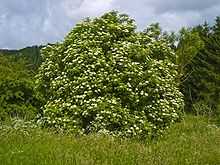 | |
| Shrub in flower | |
| Scientific classification | |
| Kingdom: | Plantae |
| (unranked): | Angiosperms |
| (unranked): | Eudicots |
| (unranked): | Asterids |
| Order: | Dipsacales |
| Family: | Adoxaceae |
| Genus: | Sambucus |
| Species: | S. nigra |
| Binomial name | |
| Sambucus nigra L. | |
Sambucus nigra is a species complex of flowering plants in the family Adoxaceae native to most of Europe.[1] Common names include elder, elderberry, black elder, European elder, European elderberry and European black elderberry.[2][3] It grows in a variety of conditions including both wet and dry fertile soils, primarily in sunny locations.
Description
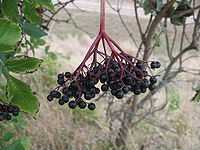
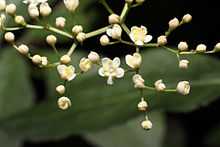
It is a deciduous shrub or small tree growing to 6 m (20 ft) tall and wide[4] (rarely 10m tall). The bark, light grey when young, changes to a coarse grey outer bark with lengthwise furrowing. The leaves are arranged in opposite pairs, 10–30 cm long, pinnate with five to seven (rarely nine) leaflets, the leaflets 5–12 cm long and 3–5 cm broad, with a serrated margin.
The hermaphrodite flowers are borne in large, flat corymbs 10–25 cm diameter in late spring to mid summer, the individual flowers ivory white, 5–6 mm diameter, with five petals; they are pollinated by flies.
The fruit is a glossy dark purple to black berry 3–5 mm diameter, produced in drooping clusters in late autumn;[4] they are an important food for many fruit-eating birds, notably blackcaps.
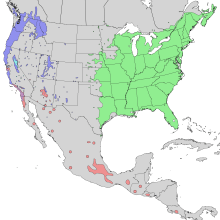
Subspecies
There are several other closely related species, native to Asia and North America, which are similar, and sometimes treated as subspecies of Sambucus nigra. The blue or Mexican elderberry, Sambucus mexicana, is now generally treated as one or two subspecies of Sambucus nigra subsp. canadensis[5] and Sambucus nigra subsp. caerulea.[6]
S. nigra is recorded as very common in Ireland in hedges as scrub in woods.[7][8]
Cultivation
Some selections and cultivars have variegated or coloured leaves and other distinctive qualities, and are grown as ornamental plants.
The following cultivars have gained the Royal Horticultural Society's Award of Garden Merit:-
- S. nigra 'Aurea' [9]
- S. nigra 'Laciniata' [10]
- S. nigra f. porphyrophylla 'Gerda' (syn. 'Black beauty')[11]
Culinary uses
The dark blue/purple berries can be eaten when fully ripe but are mildly poisonous in their unripe state.[12] All green parts of the plant are poisonous, containing cyanogenic glycosides (Vedel & Lange 1960). The berries are edible after cooking and can be used to make jam, jelly, chutney and Pontack sauce.
The flowerheads are commonly used in infusions, giving a very common refreshing drink in Northern Europe and the Balkans. Commercially these are sold as Elderflower cordial.[13] In Europe, the flowers are made into a syrup or cordial (in Romanian: Socată, in Swedish: fläder(blom)saft), which is diluted with water before drinking. The popularity of this traditional drink has recently encouraged some commercial soft drink producers to introduce elderflower-flavoured drinks (Fanta Shokata, Freaky Fläder). The flowers can also be dipped into a light batter and then fried to make elderflower fritters. In Scandinavia and Germany, soup made from the elder berry (e.g. the German Fliederbeersuppe) is a traditional meal.
Both flowers and berries can be made into elderberry wine, and in Hungary an elderberry brandy is made that requires 50 kg of fruit to produce 1 litre of brandy. In south-western Sweden, it is traditional to make a snaps liqueur flavoured with elderflower. Elderflowers are also used in liqueurs such as St. Germain, and in a mildly alcoholic sparkling elderflower 'champagne'.
In Beerse, Belgium, a variety of Jenever called Beers Vlierke is made from the berries.
Medicinal
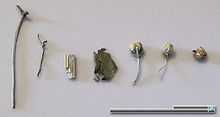
This plant is traditionally used as a medicinal plant by many native peoples and herbalists alike.[14][15] Stembark, leaves, flowers, fruits, and root extracts are used to treat bronchitis, cough, upper respiratory cold infections, and fever.
In a placebo-controlled, double-blind study, black elderberry (Sambucus nigra) was shown to be effective for treating Influenza B.[16] People using the elderberry extract recovered much faster than those only on a placebo. The study was published in the Journal of Alternative Complementary Medicine.
A small study published in 2004 showed that 93% of flu patients given extract were completely symptom-free within two days; those taking a placebo recovered in about six days. This current study shows that it works for type A flu, reports lead researcher Erling Thom, with the University of Oslo in Norway.[17] Further study confirmed the beneficial effect of elderberry on Influenza.[18]
Elderberry flowers are sold in Ukrainian and Russian drugstores for relief of congestion, specifically as an expectorant to relieve dry cough and make it productive. The dried flowers are simmered for 15 minutes, and the resulting flavorful and aromatic tea is poured through a coffee filter. Some individuals find it better hot, others cold, and some may experience an allergic reaction.
Sambucus nigra fruits and flowers have been used in traditional Austrian medicine - internally (fruits as tea, jelly, juice, or syrup; flowers as tea or syrup) for treatment of disorders of the respiratory tract, mouth, gastrointestinal tract, and skin, and for viral infections, fever, colds and flu.[19]
The flowers can be used to make an herbal tea as a remedy for inflammation caused by colds and fever.[20]
Some studies have been done on Sambucus nigra extract and its ability to act like insulin in treating diabetes due to its richness in anthocyanins, which also reduces oxidative stress.[21]It increased glucose uptake by 70%, glucose oxidation by 50%, and glycogenesis by 70% on average. It is likely that the extract uses similar pathways that insulin does, but also stimulates insulin secretion. Similar findings of plant extracts that improve glucose uptake have been discovered in mushrooms, coriander, mistletoe, eucalyptus, lucerne, and agrimony.[22]
Diseases
Like other elderberries, Sambucus nigra is subject to elder whitewash fungus.
Wildlife value
Elder rates as fair to good forage for animals such as mule deer, elk, sheep and small birds. It is classified as nesting habitat for many birds, including hummingbirds, warblers, and vireos. Elderberries are a favorite food for migrating band-tailed pigeons in northern California, which may sometimes strip an entire bush in a short time.
It is also good cover for large and small mammals.[23]
Elder is cited as a poisonous plant for mammals, and as a weed in certain habitats.[24] All parts of the plant except for the flowers and ripe berries (but including the ripe seeds) are poisonous, containing the cyanogenic glycoside sambunigrin (C14H17NO6, CAS number 99-19-4).[25] The bark contains calcium oxalate crystals.
Other uses
The strong-smelling foliage was used in the past, tied to a horse's mane, to keep flies away while riding.
References
- ↑ Sambucus nigra at Flora Europaea
- ↑ "Sambucus nigra". Integrated Taxonomic Information System.
- ↑ Sambucus nigra at USDA PLANTS Database
- ↑ 4.0 4.1 RHS A-Z encyclopedia of garden plants. United Michael and Vikram: Dorling Kindersley. 2008. p. 1136. ISBN 1405332964.
- ↑ "Sambucus mexicana". Calflora. Retrieved 2012-07-16.
- ↑ "Sambucus nigra ssp. caerulea". Calflora. Retrieved 2012-07-16.
- ↑ Hackney, P. 1992. Stewarts and Corry's Flora of the North-east of Ireland. Institute of Irish Studies The Queen's University of Belfast. ISBN 0 85389 446 9(HB)
- ↑ Webb, D.A., Parnell, J. and Doogue, D. 1996. Dundalgan Press Ltd, Dundalk. ISBN 0-85221-131-7
- ↑ "RHS Plant Selector Sambucus nigra 'Aurea' AGM / RHS Gardening". Apps.rhs.org.uk. Retrieved 2012-07-16.
- ↑ "RHS Plant Selector Sambucus nigra f. laciniata AGM / RHS Gardening". Apps.rhs.org.uk. Retrieved 2012-07-16.
- ↑ "RHS Plant Selector Sambucus nigra f. porphyrophylla 'Gerda' PBR AGM / RHS Gardening". Apps.rhs.org.uk. Retrieved 2012-07-16.
- ↑ Professor Julia Morton, University of Miami
- ↑ Kikbracken, J. 1995. Easy way guide Trees. Larousse.
- ↑
- ↑ "Mojave Desert Large Shrubs and Vines". Offroadinghome.djmed.net. Retrieved 2012-07-16.
- ↑ Zakay-Rones Z, Varsano N, Zlotnik M, Manor O, Regev L, Schlesinger M, Mumcuoglu M (1995). "Inhibition of Several Strains of Influenza Virus in Vitro and Reduction of Symptoms by an Elderberry Extract (Sambucus nigra L.) during an Outbreak of Influenza B Panama" (PDF). J Altern Complement Med 1 (4): 361–9. doi:10.1089/acm.1995.1.361. PMID 9395631. Retrieved September 8, 2009.
- ↑ Zakay-Rones Z, Thom E, Wollan T, Wadstein J (April 2004). "Randomized Study of the Efficacy and Safety of Oral Elderberry Extract in the Treatment of Influenza A and B Virus Infections" (PDF). Journal of International Medical Research 32 (2): 132–140. doi:10.1177/147323000403200205. PMID 15080016.
- ↑ Kinoshita E, Hayashi K, Katayama H, Hayashi T, Obata A (2012) [original online publication: 7 September 2012]. "Anti-influenza virus effects of elderberry juice and its fractions". Bioscience, Biotechnology, and Biochemistry 76 (9): 1633–1638. doi:10.1271/bbb.120112. PMID 22972323.
- ↑ Vogl S, Picker P, Mihaly-Bison J, Fakhrudin N, Atanasov AG, Heiss EH, Wawrosch C, Reznicek G, Dirsch VM, Saukel J, Kopp B (7 October 2013) [Epub ahead of print: 13 June 2013]. "Ethnopharmacological in vitro studies on Austria's folk medicine - An unexplored lore in vitro anti-inflammatory activities of 71 Austrian traditional herbal drugs". J Ethnopharmacol 149 (3): 750–771. doi:10.1016/j.jep.2013.06.007. PMC 3791396. PMID 23770053. doi:pii: S0378-8741(13)00410-8.
- ↑ Harokopakis E, Albzreh MH, Haase EM, Scannapieco FA, Hajishengallis G (February 2006). "Inhibition of Proinflammatory Activities of Major Periodontal Pathogens by Aqueous Extracts From Elder Flower (Sambucus nigra)". Journal of Periodontology 77 (2): 271–279. doi:10.1902/jop.2006.050232. Retrieved 2012-07-16.
- ↑ Badescu, Magda; Badulescu, Oana; Badescu, Laurentiu; Clocolu, Manuela (April 2015). "Effects of Sambucus nigra and Aronia melanocarpa extracts on immune system disorders within diabetes mellitus". Pharmaceutical Biology 53 (4): 533–539. doi:10.3109/13880209.2014.931441.
- ↑ Gray, Alison M.; Abdel-Wahab, Yasser H. A.; Flatt, Peter R. (1 January 2000). "The traditional plant treatment, Sambucus nigra (elder), exhibits insulin-like and insulin-releasing actions in vitro". The American Society for Nutritional Sciences 130 (1): 15-20. Retrieved 28 April 2015.
- ↑ CONSIDERATIONS
- ↑ Sambucus nigra at Germplasm Resources Information Network
- ↑ Campa C, Schmitt-Kopplin P, Cataldi TR, Bufo SA, Freitag D, Kettrup A (2000). "Analysis of cyanogenic glycosides by micellar capillary electrophoresis". Journal of Chromatography B 739: 95–100. doi:10.1016/S0378-4347(99)00375-8. PMID 10744317.
Further reading
- Blanchan, Neltje (1900). Wild Flowers: An Aid to Knowledge of our Wild Flowers and their Insect Visitors. New York City: Doubleday. OCLC 16950204.
- Rushforth, K. (1999). Trees of Britain and Europe. HarperCollins ISBN 0-00-220013-9.
- Bratu, Mihaela Mirela; Doroftei, Elena; Negreanu-Pirjol, Ticuta; Hostina, Corina; Porta, Sepp (April 2012). "Determination of Antioxidant Activity and Toxicity of Sambucus nigra Fruit Extract Using Alternative Methods". Food Technology and Biotechnology 50 (2): 177-182. ISSN 1330-9862.
External links
| Wikimedia Commons has media related to Sambucus nigra. |